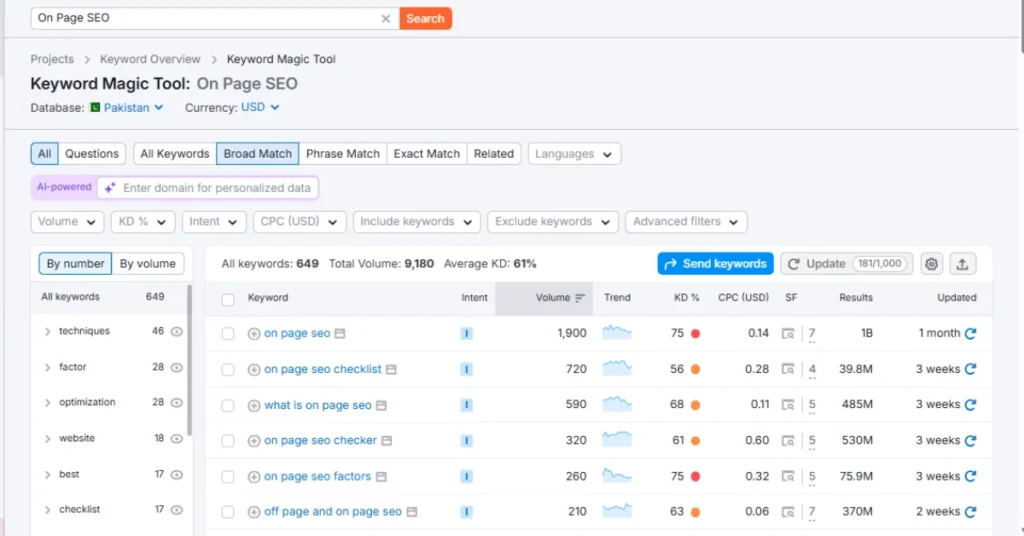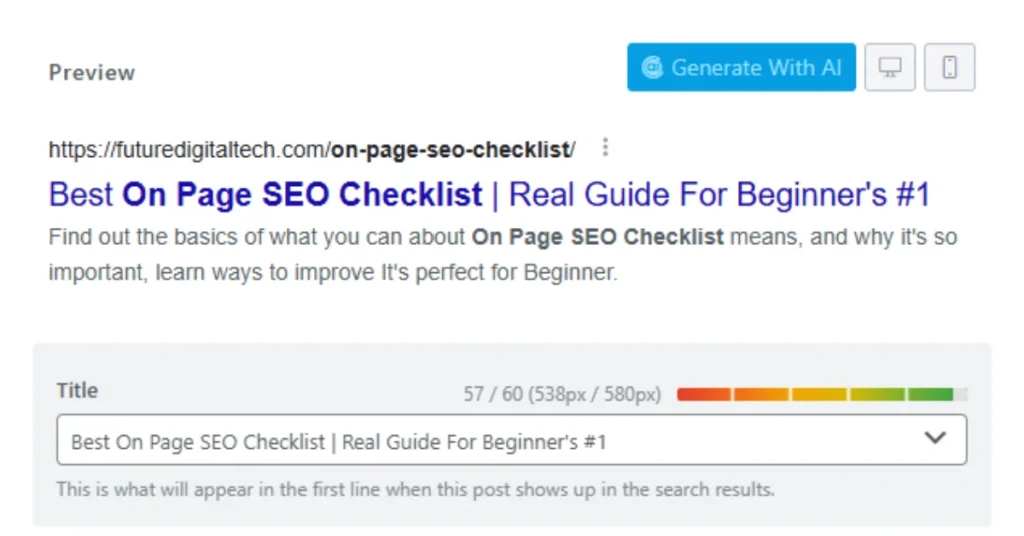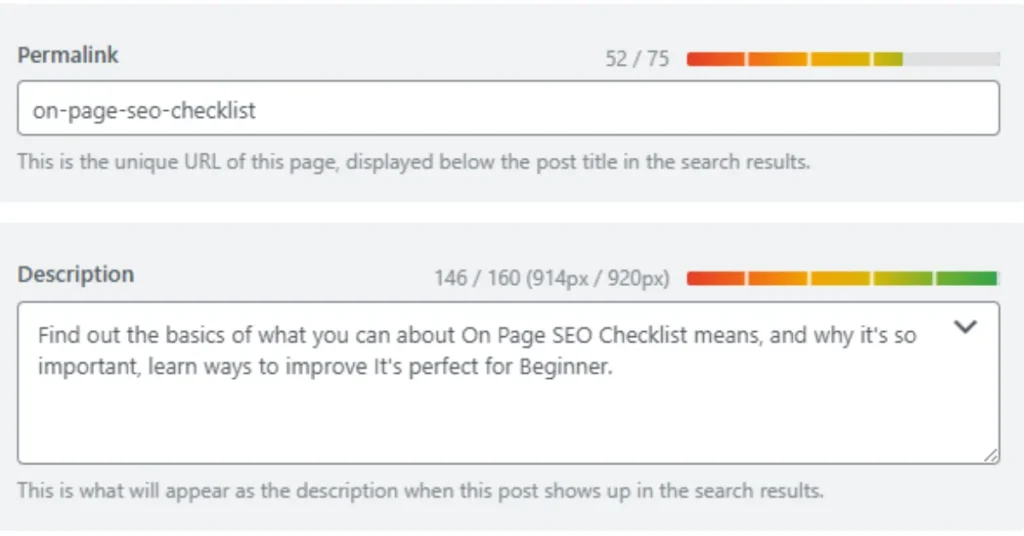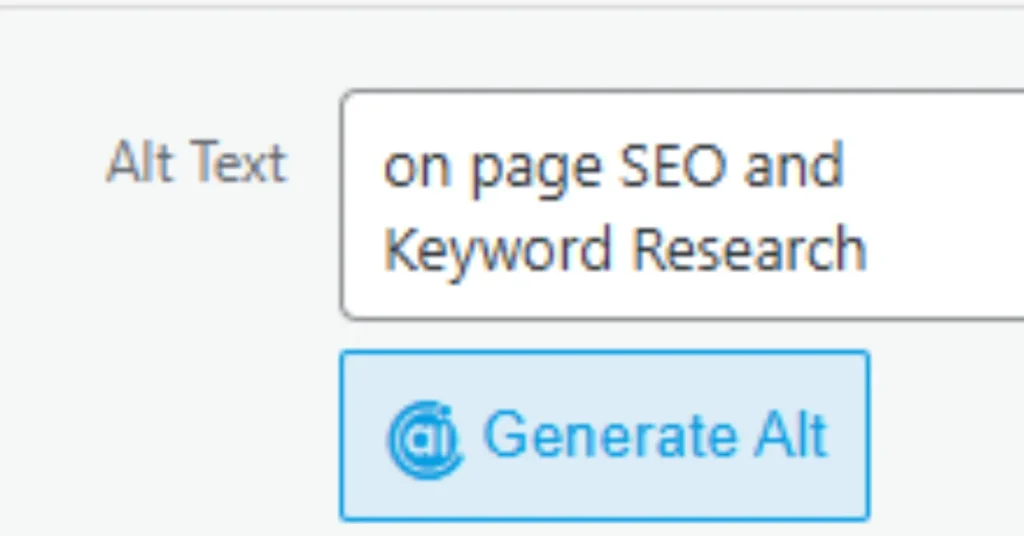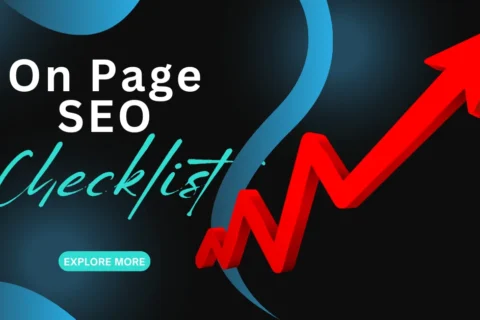What is On Page SEO? A Complete Beginner-Friendly Guide (With Checklist )
Do you want your site to rank better on Google? The first step to take is to Master SEO for On-Page- an effective strategy Or on-page seo best practices that aid search engines in understanding your website’s content better.
We’ll explain the essential information you must learn about on-page SEO Factors, explain why they’re crucial, and give you a clear, step-by-step checklist that anyone can follow. There will be no technical jargon, simply clear, user-friendly guidelines.
What is On Page SEO?
Define On Page SEO (also known as on-site SEO) is the act of optimizing web pages so that they rank better and get more visitors in search engines.
On Page SEO Definition is that the process of optimizing the content, HTML tags, URL structure along with other aspects directly on the web-pagein contrast to on page seo services which focuses on external factors such as backlinks.
Why On Page SEO is Important?
Search engines such as Google strive to give the most effective results for users. By optimizing your web pages for SEO on the page it will help you:
- Help it be easier for Google to comprehend your web page
- Enhance your chances to getting at the top of your search results
- Enhance user experience (UX) and engage visitors
- Improve the amount of your natural web traffic as well as the potential conversions
Interesting Facts: Google utilizes more than two hundred ( 200 ) rank factors — a lot of them are SEO elements on pages! for your ranking of your website.
✅ On Page SEO Checklist and Keyword Research (With Explanations)
This is your must-have on-page SEO checklist, stuffed with all the key important on page seo factors that affect rankings and the best methods:
1. Begin by doing Keyword Research
Prior to anything else, you must locate the right keywords to focus on.
- Make use of many SEO tools like Ahrefs, SEMrush, or Google Keyword Planner
- Find key words with a high volume, but with low to medium competition
- Concentrate upon the long tail keywords (e.g., “how to do on page SEO step by step”)
Example of a seed term includes “on page SEO”, relevant keywords could include “on page seo checklist,” “technical on page seo,” “on page seo vs off page,” “on page seo audit” and so many others likes thats term.
2. Craft an SEO-Friendly Title Tag
- Keep it under 60 characters
- Include your principal keyword naturally
- Make it click-worthy
Example: On Page SEO Guide for Beginners: Checklist + Tips
3. Write a Compelling Meta Description
- Use 155-160 characters
- Summing up the content in a clear manner
- Add a call to action (CTA) if possible
Example: Get started with On Page SEO right from the beginning with our step-by -step checklist. Increase your Google rankings today!
4. Use a Clean, Keyword-Rich URL
- Keep it short and readable
- Include the main keyword
- Avoid words that stop (like and the of)
Example:
https://futuredigitaltech.com/on-page-seo-guide
5. Optimize Your Headings (H1, H2, H3 …)
- Use only one H1 in one time (main title)
- Include related keywords in H2s and H3s
- Make sure your content is organized in a good and clear way for both users as well as search engines for easy understanding.
6. Create High-Quality, Valuable Content
- Write for humans first, then search engines next.
- Use a simple syntax and make paragraphs brief
- Include keywords naturally (avoid keyword stuffing)
- cover each aspect related to the subject to increase the authority of the topic.
Add helpful elements:
- Bullet points
- Tables
- Examples
- Images & screenshots
7. Use Internal Linking
- Hyperlink on to pertinent content on your website
- Helps Google crawl your website better results for your site.
- Keeps users engaged longer with you and your site.
Example: In the SEO article, include a link to your blog post on “Technical SEO” or “Off Page SEO ” or “Local SEO”.
8. Optimize Image SEO
- Use descriptive file names
- Add alt text with relevant keywords for images
- compress images to improve speed of the site( .Webp) formate
Example:
Alt Text: “On Page SEO Checklist for Beginners”
9. Improve Page Speed
Google loves fast-loading pages!
- Use tools like Google PageSpeed Insights
- Compress images using tools like TinyPNG
- Minify CSS/JS files, and enable caching for browsers
10. Make It Mobile-Friendly
Over 60% of all traffic is mobile! Your website needs to be mobile-friendly.
- Use themes that are mobile-friendly (like the impreza theme )
- Check mobile usability in Google Search Console
11. Use Schema Markup (Structured Data)
- Helps search engines understand your content type
- Enhances the chance of rich snippets of information (stars or FAQs, etc. )
Example add Article schemas in blog entries.
12. Use SEO Plugins (For WordPress Sites)
- Yoast SEO or Rank Math help optimize meta tags, sitemaps, and more.
- They also provide on-page SEO reviews and recommendations
13. Add External Links to Authoritative Sources
- Boosts credibility
- Increases trust in Google
Example A link to Google’s official SEO Starter Guide or reputable blogs such as Moz, Ahrefs, etc.
14. Create SEO-Friendly Content Structure
- Make use of Tables of Content for lengthy articles
- Add FAQ sections
- Use clear formatting for better UX
🌐 Bonus: On Page SEO Technical Tips
While technical SEO is generally an individual topic but here are some factors that are technical in on page SEO to be aware of:
- Use HTTPS (SSL certificate)
- Use a clear URL structure
- Avoid duplicate content
- Create and upload the XML sitemap
- Fix crawl issues as well as broken hyperlinks
[VS] On Page SEO vs Off Page SEO – What’s the Difference?
Feature of On Page SEO Off Page SEO
Focus Page content & structure Backlinks & external signals
Control Completely controlled by you. Not completely in your control
Techniques Keywords, meta tags, URLs, internal links Backlink building, social shares
Tools Yoast, Rank Math, Screaming Frog Ahrefs, Semrush, Moz
Final Thoughts: Mastering On Page SEO
If you’re a blogger an owner of a business, or a digital marketer using for digital marketing or a digital marketer, On Page SEO is the basis for greater rankings and increased visibility. Concentrate on the quality of your content as well as user experience and technical optimization and you’ll be on the road to success with SEO.
Recap: On Page SEO Quick Checklist
- Do keyword research
- Use keywords in title, URL, and meta description
- Optimize headings (H1, H2, etc. )
- Add internal and external hyperlinks
- Write original, valuable content
- Compress & optimize images
- Improve mobile usability
- Speed up your site
- Add schema markup
- Use SEO plugins (Yoast, Rank Math)
- Avoid keyword stuffing
- Make content simple to be read and eaasy understand
Do you want more SEO-related tips, tutorials or instruments?
Check out other helpful guides at FutureDigitalTech.com
Call-to-Action: Ready to Boost Your SEO Rankings?
If you’re just beginning Don’t worry about it SEO on the web isn’t difficult, however it will require patience and a strategy that works. Follow the steps in this guide, utilize the tools we’ve mentioned, and begin tracking your improvement.
Follow this guide
It is shared with your team members or your fellow bloggers
And most importantly — start optimizing today!
Visit FutureDigitalTech.com for more guides, tips, and tools to level up your digital game.
Frequently Asked Question (FAQs)
What is the most crucial On Page SEO factors?
The most significant factors comprise:
- High-quality, keyword-optimized content
- Meta tags and title tags. D descriptions
- Proper heading structure (H1, H2, H3…)
- Internal linking
- Image optimization (alt text + compression)
- Fast loading speed
- Mobile responsiveness
- URL structure
What's the distinction between SEO Off Page SEO?
- On-Page SEO is all that you put on your site by optimizing images, content Meta tags, images, etc.
- Off Page SEO encompasses all you do off your site, such as creating backlinks, social media promotions and even brand mentions.
Both are essential However, on page SEO is the foundation.
What tools can I utilize to check my SEO on Page SEO?
A few of the most effective on page seo tool or on page seo plugin for wordpress are:
- Yoast SEO (WordPress plugin)
- SEMrush On Page SEO Checker
- Ahrefs Site Audit Tool
- Screaming Frog SEO Spider
- Google Search Console
- Ubersuggest
These tools can help you identify problems in your HTML code, tags that are not present broken links, other areas for improvement.
Do I have the ability to perform On Page SEO myself or get someone else to do it?
Absolutely you can do it yourself, particularly with tools for beginners like Yoast and Rank Math. In contrast, for large websites or competitive sectors using an SEO professional or agency could aid in speeding up the process.
On Page SEO Checklist
What is On Page SEO? A Complete Beginner-Friendly Guide (With Checklist ) Do you want your…
April 5, 2025 0
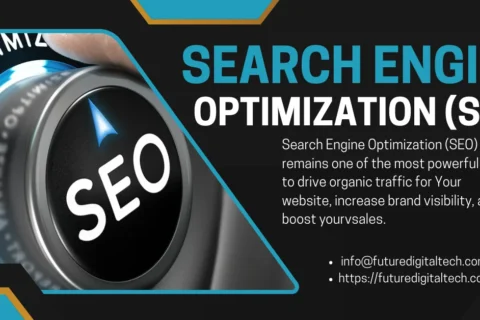
Digital Marketing
Search Engine Optimization SEO: The Complete Guide for Beginners
🔍 What Is Search Engine Optimization? In the fast-paced world of digital marketing, Search Engine…
March 31, 2025 0

Digital Marketing
What Is Digital Marketing?
What Is Digital Marketing? In the digital age the way businesses interact with their customers…
Future Digital Tech
Future Digital Technology The Evolution of Technology in the Digital Age In our fast-paced society,…
March 16, 2025 0
On Page SEO Checklist
April 5, 2025 0
Digital Marketing
Search Engine Optimization SEO: The Complete Guide for Beginners
March 31, 2025 0
Digital Marketing
What Is Digital Marketing?
Future Digital Tech
March 16, 2025 0


